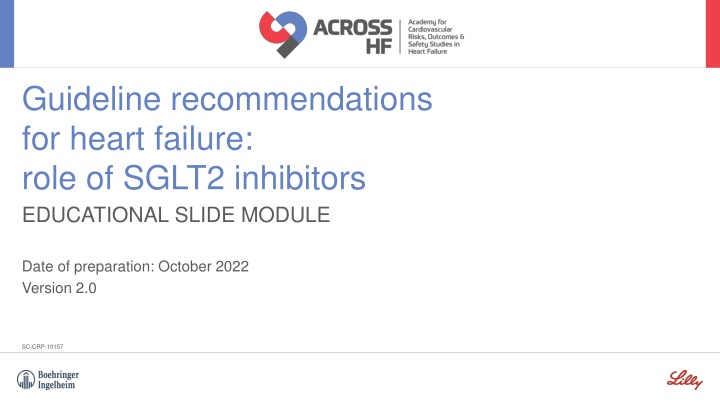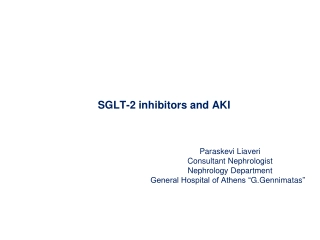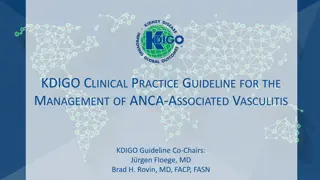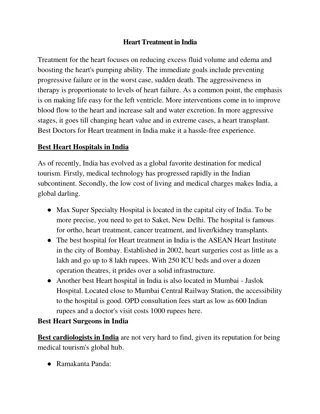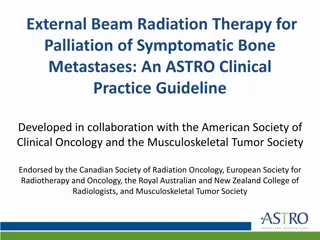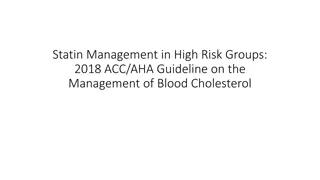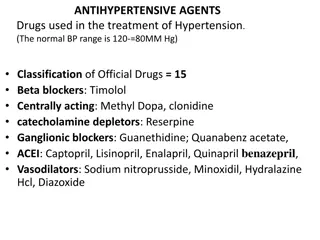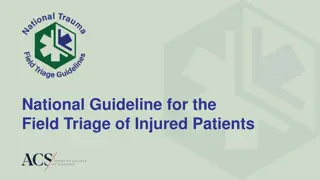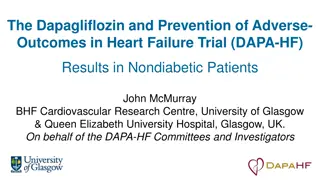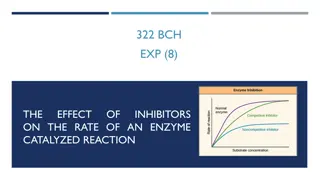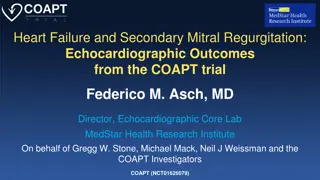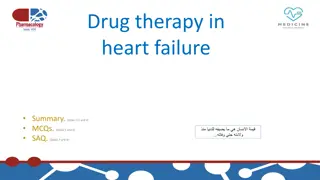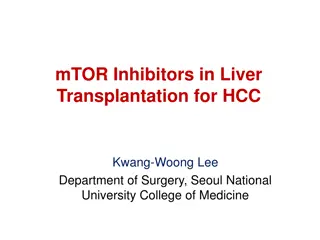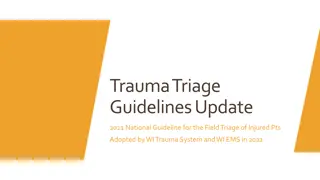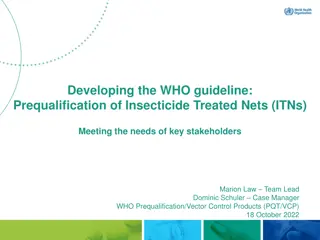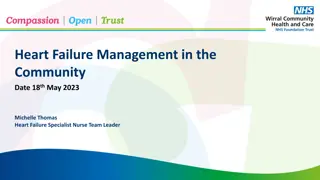Guideline Recommendations for SGLT2 Inhibitors in Heart Failure
This educational slide module provides an overview of the guideline recommendations for SGLT2 inhibitors in the treatment of heart failure, including HFrEF, HFmrEF, and HFpEF. It covers recommendations from AHA, ACC, HFSA, ESC, CCS, and CHFS guidelines, highlighting the role of SGLT2 inhibitors as a foundational pillar in heart failure treatment strategies.
Download Presentation

Please find below an Image/Link to download the presentation.
The content on the website is provided AS IS for your information and personal use only. It may not be sold, licensed, or shared on other websites without obtaining consent from the author.If you encounter any issues during the download, it is possible that the publisher has removed the file from their server.
You are allowed to download the files provided on this website for personal or commercial use, subject to the condition that they are used lawfully. All files are the property of their respective owners.
The content on the website is provided AS IS for your information and personal use only. It may not be sold, licensed, or shared on other websites without obtaining consent from the author.
E N D
Presentation Transcript
Guideline recommendations for heart failure: role of SGLT2 inhibitors EDUCATIONAL SLIDE MODULE Date of preparation: October 2022 Version 2.0 SC-CRP-10157
Module objective The aim of this educational slide module is to: Provide an overview of the guideline recommendations for SGLT2 inhibitors in the treatment of HFrEF, HFmrEF and HFpEF as outlined in clinical practice guidelines 1 2 HFmrEF, heart failure with mildly reduced ejection fraction; SGLT2, sodium-glucose co-transporter-2
Guideline recommendations for heart failure: role of SGLT2 inhibitors Introduction AHA/ACC/HFSA Guideline ESC Guidelines CCS/CHFS Guidelines Summary AHA, American Heart Association; CCS, Canadian Cardiovascular Society; CHFS, Canadian Heart Failure Society; ESC, European Society of Cardiology; HFSA, Heart Failure Society of America; SGLT2, sodium-glucose co-transporter-2
Recommendations for SGLT2 inhibitors in heart failure: overview HFmrEF (LVEF 41 49%) HFrEF (LVEF 40%) HFpEF (LVEF 50%) 2021 CCS/CHFS Guidelines1 2022 AHA/ACC/HFSA Guideline3 HFmrEF SGLT2 inhibitors have a Class 2a recommendation in HFmrEF ARNi, ACEi, ARB, MRA and BB have Class 2b recommendations in HFmrEF 2021 ESC Guidelines2 2022 AHA/ACC/HFSA Guideline3 HFpEF SGLT2 inhibitors have a Class 2a recommendation in HFpEF ARNi, ARB and MRA have Class 2b recommendations in HFpEF All include SGLT2 inhibitors as first- line therapy for HFrEF (Class 1 recommendation), creating a four foundational pillars treatment strategy Note: Only the AHA/ACC/HFSA Guideline was published AFTER disclosure of the EMPEROR-Preserved trial AHA, American Heart Association; BB, beta blocker; CCS, Canadian Cardiovascular Society; CHFS, Canadian Heart Failure Society; ESC, European Society of Cardiology; HFmrEF, heart failure with mildly reduced ejection fraction; HFSA, Heart Failure Society of America; MRA, mineralocorticoid receptor antagonist; SGLT2, sodium-glucose co-transporter-2 1. McDonald M et al. Can J Cardiol 2021;37:531; 2. McDonagh TA et al. Eur Heart J 2021;42:3599; 3. Heidenreich PA et al. J Am Coll Cardiol 2022;79:e263 4
HFrEF guideline recommendations for SGLT2 inhibitors are based on data from phase III trials DAPA-HF: dapagliflozin 10 mg once daily significantly reduced the risk of worsening HF* or CV death in patients with HFrEF with or without diabetes Primary composite outcome Secondary outcomes Worsening HF* or CV death Composite kidney outcome KCCQ Total Symptom Score Total HHF and CV death events HHF or CV death All-cause mortality 26% RRR HR 0.74 (95% CI 0.65, 0.85) p<0.001 1.18 rate ratio (95% CI 1.11, 1.26) p<0.001 25% RRR HR 0.75 (95% CI 0.65, 0.85) p<0.001 25% RRR HR 0.75 (95% CI 0.65, 0.88) p<0.001 HR 0.83 (95% CI 0.71, 0.97) NA HR 0.71 (95% CI 0.44, 1.16) NA Median follow-up, 18.2 months; 41.8% of patients in each group had a history of T2D *Unplanned HHF or urgent visit resulting in intravenous therapy for HF; NA denotes not applicable because p-values for efficacy outcomes are reported only for outcomes that were included in the hierarchical testing strategy HHF, hospitalisation for heart failure; KCCQ, Kansas City Cardiomyopathy Questionnaire; NA, not applicable; RRR, relative risk reduction; SGLT2, sodium- glucose co-transporter-2; T2D, type 2 diabetes. McMurray J et al. N Engl J Med 2019;381:1995 5
HFrEF guideline recommendations for SGLT2 inhibitors are based on data from phase III trials EMPEROR-Reduced: empagliflozin 10 mg once daily significantly reduced the risk of CV death or HHF in patients with HFrEF with or without diabetes Primary composite outcome Secondary outcomes Change in eGFR slope (difference per year vs placebo) CV death or HHF Total (first and recurrent) HHF events +1.73 ml/min/1.73 m2 (95% CI 1.10, 2.37) p<0.001 25% RRR 30% RRR HR 0.75 (95% CI 0.65, 0.86) p<0.001 HR 0.70 (95% CI 0.58, 0.85) p<0.001 Median follow-up, 16.0 months; 49.8% of patients in each group had a history of T2D HHF, hospitalisation for heart failure; RRR, relative risk reduction; SGLT2, sodium-glucose co-transporter-2; T2D, type 2 diabetes Packer M et al. N Engl J Med 2020;383:1413 6
HFmrEF and HFpEF: AHA/ACC/HFSA guidance is based on data from EMPEROR-Preserved EMPEROR-Preserved: empagliflozin 10 mg once daily significantly reduced the risk of CV death or HHF in patients with LVEF >40% with or without diabetes Primary composite outcome Secondary outcomes Change in eGFR slope (difference per year vs placebo) CV death or HHF Total (first and recurrent) HHF events +1.36 ml/min/1.73 m2 (95% CI 1.06, 1.66) p<0.001 21% RRR 27% RRR HR 0.79 (95% CI 0.69, 0.90) p<0.001 HR 0.73 (95% CI 0.61, 0.88) p<0.001 AHA, American Heart Association; HFmrEF, heart failure with mildly reduced ejection fraction; HFSA, Heart Failure Society of America; HHF, hospitalisation for heart failure; RRR, relative risk reduction Anker S et al. N Engl J Med 2021;385:1451 7
Guideline recommendations for heart failure: role of SGLT2 inhibitors Introduction AHA/ACC/HFSA Guideline ESC Guidelines CCS/CHFS Guidelines Summary AHA, American Heart Association; CCS, Canadian Cardiovascular Society; CHFS, Canadian Heart Failure Society; ESC, European Society of Cardiology; HFSA, Heart Failure Society of America; SGLT2, sodium-glucose co-transporter-2
Key changes to HFrEF, HFmrEF and HFpEF treatment in the 2022 AHA/ACC/HFSA Guideline New Class 1 recommendation in HFrEF: SGLT2 inhibitors are recommended irrespective of the presence of type 2 diabetes In patients with HFrEF, the four foundational drug therapies* may be initiated simultaneously at low doses, or sequentially guided by clinical or other factors New Class 2a recommendations in HFmrEF and HFpEF: SGLT2 inhibitors can be beneficial to decrease hospitalisations and CV mortality *SGLT2 inhibitors, ACEi/ARB/ARNi, MRA, beta blocker. See slide notes for definitions of classes of recommendation and levels of evidence AHA, American Heart Association; HFmrEF, heart failure with mildly reduced ejection fraction; HFSA, Heart Failure Society of America; MRA, mineralocorticoid receptor antagonist; SGLT2, sodium-glucose co-transporter-2 Heidenreich PA et al. J Am Coll Cardiol 2022;79:e263 9
HFrEF: SGLT2 inhibitors are included as Step 1 GDMT; Step 1 treatments should be started simultaneously or sequentially without delay Step 1 Step 2 Step 3 Step 4 Step 5 Step 6 Establish diagnosis of HFrEF Address congestion Initiate GDMT Titrate to target dosing as tolerated, labs, health status and LVEF Consider these patient scenarios Implement additional GDMT and device therapy, as indicated Reassess symptoms, labs, health status and LVEF Referral for HF specialty care for additional therapy NYHA III IV, in African American patients In select patients, durable MCS (1) HFrEF LVEF 40% (Stage C) Hydral-nitrates (1) NYHA I III; LVEF 35%; >1 yr survival ARNi in NYHA II III; ACEi or ARB in NYHA II IV (1) Refractory HF (Stage D) ICD (1) Cardiac transplant (1) NYHA II III; ambulatory IV; LVEF 35%; NSR and QRS 150 ms with LBBB Palliative care (1) (can be initiated before Stage D) LVEF 40% Persistent HFrEF (Stage C) Beta blocker (1) CRT-D (1) Symptoms improved LVEF >40% HFimpEF (Stage C) MRA (1) Investigational studies* Consider additional therapies SGLT2i (1) Diuretics as needed (1) Continue GDMT with serial reassessment and optimise dosing, adherence and patient education, address goals of care *Participation in investigational studies is appropriate for Stage C, NYHA class II and III HF. See slide notes for abbreviations and definitions of classes of recommendation and levels of evidence. Heidenreich PA et al. J Am Coll Cardiol 2022;79:e263 10
HFrEF: SGLT2 inhibitors are included as Step 1 GDMT; Step 1 treatments should be started simultaneously or sequentially without delay Step 1 Step 2 Step 3 Step 4 Step 5 Step 6 Establish diagnosis of HFrEF Address congestion Initiate GDMT Titrate to target dosing as tolerated, labs, health status, and LVEF Consider these patient scenarios Implement additional GDMT and device therapy, as indicated Reassess symptoms, labs, health status, and LVEF Referral for HF specialty care for additional therapy NYHA III IV, in African American patients In select patients, durable MCS (1) HFrEF LVEF 40% (Stage C) Hydral-nitrates (1) Step 1 medications may be started simultaneously at initial (low) doses recommended for HFrEF. Alternatively, these medications may be started sequentially, with sequence guided by clinical or other factors, without need to achieve target dosing before initiating next medication. NYHA I III; LVEF 35%; >1 yr survival ARNi in NYHA II III; ACEi or ARB in NYHA II IV (1) Refractory HF (Stage D) ICD (1) Cardiac transplant (1) NYHA II III; ambulatory IV; LVEF 35%; NSR and QRS 150 ms with LBBB Palliative care (1) (can be initiated before Stage D) LVEF 40% Persistent HFrEF (Stage C) Beta blocker (1) CRT-D (1) Symptoms improved In patients with HFrEF, the order of guideline-directed medications is usually individualised , LVEF >40% HFimpEF (Stage C) does not necessarily need to be done according to the sequence of trial publications and should not be delayed. MRA (1) Investigational studies* Consider additional therapies SGLT2i (1) Diuretics as needed (1) Continue GDMT with serial reassessment and optimise dosing, adherence and patient education, address goals of care *Participation in investigational studies is appropriate for Stage C, NYHA class II and III HF. See slide notes for abbreviations and definitions of classes of recommendation and levels of evidence. Heidenreich PA et al. J Am Coll Cardiol 2022;79:e263 11
HFrEF: SGLT2 inhibitors have Class 1A recommendations, based on high-quality evidence from >1 RCT COR LOE Recommendations for renin-angiotensin system inhibition with ACEi or ARB or ARNi 1. In patients with HFrEF and NYHA class II III symptoms, the use of ARNi is recommended to reduce morbidity and mortality 1 A 2. In patients with previous or current symptoms of chronic HFrEF, the use of ACEi is beneficial to reduce morbidity and mortality when the use of ARNi is not feasible 1 A 3. In patients with previous or current symptoms of chronic HFrEF who are intolerant to ACEi because of cough or angioedema and when the use of ARNi is not feasible, the use of ARB is recommended to reduce morbidity and mortality 1 A 5. In patients with chronic symptomatic HFrEF NYHA class II or III who tolerate an ACEi or ARB, replacement by an ARNi is recommended to further reduce morbidity and mortality 1 B-R COR LOE Recommendations for beta blockers 1. In patients with HFrEF, with current or previous symptoms, use of 1 of the 3 beta blockers proven to reduce mortality (e.g. bisoprolol, carvedilol, sustained-release metoprolol succinate) is recommended to reduce mortality and hospitalisations 1 A COR LOE Recommendations for mineralocorticoid receptor antagonists (MRAs) 1. In patients with HFrEF and NYHA class II IV symptoms, an MRA (spironolactone or eplerenone) is recommended to reduce morbidity and mortality, if eGFR is >30 ml/min/1.73 m2 and serum potassium is <5.0 mEq/l. Careful monitoring of potassium, renal function and diuretic dosing should be performed at initiation and closely monitored thereafter to minimise risk of hyperkalaemia and renal insufficiency 1 A COR LOE Recommendations for SGLT2 inhibitors 1. In patients with symptomatic chronic HFrEF, SGLT2i are recommended to reduce hospitalisation for HF and cardiovascular mortality, irrespective of the presence of type 2 diabetes 1 A Value statement recommendations not shown. See slide notes for definitions of classes of recommendation (COR) and levels of evidence (LOE) NYHA, New York Heart Association; RCT, randomised controlled trial; SGLT2(i), sodium-glucose co-transporter-2 (inhibitor) Heidenreich PA et al. J Am Coll Cardiol 2022;79:e263 12
HFmrEF and HFpEF: SGLT2 inhibitors included in new treatment algorithms Treatment of HFmrEF Treatment of HFpEF Diuretics as needed (1) Diuretics as needed (1) SGLT2i (2a) SGLT2i (2a) Symptomatic HF with LVEF 41 49% Symptomatic HF with LVEF 50% ACEi, ARB, ARNi (2b) ARNi* (2b) MRA (2b) MRA* (2b) Evidence-based beta blockers for HFrEF (2b) ARB* (2b) *Greater benefit in patients with LVEF closer to 50% Class and strength of recommendations: 2a: moderate strength of recommendation; benefit >> risk. 2b: weak recommendation; benefit risk. See slide notes for definitions of all classes of recommendation and levels of evidence. HFmrEF, heart failure with mildly reduced ejection fraction; MRA, mineralocorticoid receptor antagonist; SGLT2(i), sodium-glucose co-transporter-2 (inhibitor) Heidenreich PA et al. J Am Coll Cardiol 2022;79:e263 13
HFmrEF and HFpEF: guidelines emphasise role of SGLT2 inhibitors in decreasing HF hospitalisations and CV mortality COR LOE Recommendations for HF with mildly reduced ejection fraction 1. In patients with HFmrEF, SGLT2i can be beneficial in decreasing HF hospitalisations and cardiovascular mortality 2a B-R 2. Among patients with current or previous symptomatic HFmrEF (LVEF 41 49%), use of evidence-based beta blockers for HFrEF, ARNi, ACEi or ARB, and MRAs may be considered to reduce the risk of HF hospitalisation and cardiovascular mortality, particularly among patients with LVEF on the lower end of this spectrum 2b B-NR COR LOE Recommendations for HF with preserved ejection fraction 1. Patients with HFpEF and hypertension should have medication titrated to attain blood pressure targets in accordance with published clinical practice guidelines to prevent morbidity 1 C-LD 2. In patients with HFpEF, SGLT2i can be beneficial in decreasing HF hospitalisations and cardiovascular mortality 2a B-R 3. In patients with HFpEF, management of AF can be useful to improve symptoms 2a C-EO 4. In selected patients with HFpEF, MRAs may be considered to decrease hospitalisations, particularly among patients with LVEF on the lower end of this spectrum 2b B-R 5. In selected patients with HFpEF, the use of ARB may be considered to decrease hospitalisations, particularly among patients with LVEF on the lower end of this spectrum 2b B-R 6. In selected patients with HFpEF, ARNi may be considered to decrease hospitalisations, particularly among patients with LVEF on the lower end of this spectrum 2b B-R 3: No benefit 7. In patients with HFpEF, routine use of nitrates or phosphodiesterase-5 inhibitors to increase activity or QoL is ineffective B-R See slide notes for abbreviations and definitions of classes of recommendations (COR) and levels of evidence (LOE) Heidenreich PA et al. J Am Coll Cardiol 2022;79:e263 14
Guideline recommendations for heart failure: role of SGLT2 inhibitors Introduction AHA/ACC/HFSA Guideline ESC Guidelines CCS/CHFS Guidelines Summary AHA, American Heart Association; CCS, Canadian Cardiovascular Society; CHFS, Canadian Heart Failure Society; ESC, European Society of Cardiology; HFSA, Heart Failure Society of America; SGLT2, sodium-glucose co-transporter-2
2021 ESC Guidelines emphasise importance of initiating the four foundational therapies as quickly as possible, and tailoring treatment New Class I recommended therapy for HFrEF: the SGLT2 inhibitors dapagliflozin and empagliflozin The four key drug therapies* should be initiatedas quickly and safely as possible Importance of tailored management according to HFrEF phenotype and patient characteristics *SGLT2 inhibitors, ACEi/ARNi, MRA, beta blocker ESC, European Society of Cardiology; MRA, mineralocorticoid receptor antagonist; SGLT2, sodium-glucose co-transporter-2 McDonagh TA et al. Eur Heart J 2021;42:3599; Gardener RS. New recommendations for the treatment of HFrEF. Oral presentation at ESC 2021 16
2021 ESC Guidelines include new Class I recommendation for SGLT2 inhibitors in patients with HFrEF to reduce risk of HHF and death Management of patients with HFrEF ACEi/ARNi* Beta blocker MRA Dapagliflozin/Empagliflozin Loop diuretic for fluid retention (Class I) LVEF >35% or device therapy not indicated or inappropriate SR and LVEF 35% and QRS <130 ms and where appropriate LVEF 35% and QRS 130 ms CRT-D /-P ICD Non-ischaemic (Class IIa) Ischaemic (Class I) QRS 130 149 ms (Class IIa) QRS 150 ms (Class I) If symptoms persist, consider therapies with Class II recommendations Class I recommendations are shown in green; Class IIa recommendations are shown in yellow *As a replacement for ACEi; Where appropriate. See slide notes for abbreviations McDonagh TA et al. Eur Heart J 2021;42:3599 17
The inclusion of SGLT2 inhibitors is based on the highest class of recommendation and highest level of evidence Recommendations Class* Level An ACEi is recommended for patients with HFrEF to reduce the risk of HF hospitalisation and death I A A beta blocker is recommended for patients with stable HFrEF to reduce the risk of HF hospitalisation and death I A An MRA is recommended for patients with HFrEF to reduce the risk of HF hospitalisation and death I A Dapagliflozin or empagliflozin are recommended for patients with HFrEF to reduce the risk of HF hospitalisation and death I A Sacubitril/valsartan is recommended as a replacement for an ACEi in patients with HFrEF to reduce the risk of HF hospitalisation and death I B *Class of recommendation; Level of evidence MRA, mineralocorticoid receptor antagonist; SGLT2, sodium-glucose co-transporter-2 McDonagh TA et al. Eur Heart J 2021;42:3599 18
Additional treatment options beyond the four foundational therapies are recommended for specific patient characteristics To reduce mortality for all patients ACEi/ARNi BB MRA SGLT2i To reduce HF hospitalisation/mortality for selected patients Volume overload Diuretics SR with LBBB 130 149 ms or non LBBB 150 ms CRT-P/D SR with LBBB 150 ms CRT-P/D Ischaemic aetiology ICD Non-ischaemic aetiology ICD AF AF Coronary artery disease CABG Iron deficiency Ferric carboxymaltose Anticoagulation Digoxin PVI Aortic stenosis SAVR/TAVI Mitral regurgitation TEE MV repair Heart rate SR >70 bpm Ivabradine Black race Hydralazine/ISDN ACEi/ARNi intolerance ARB For selected advanced HF patients Heart transplantation MCS as BTT/BTC Long-term MCS as DT To reduce HF hospitalisation and improve QoL for all patients Multiprofessional disease management Exercise rehabilitation Class I recommendations are shown in green; Class IIa recommendations are shown in yellow. See slide notes for abbreviations McDonagh TA et al. Eur Heart J 2021;42:3599 19
ESC Guidelines were published before the disclosure of EMPEROR- Preserved, so SGLT2 inhibitors are not considered in HFmrEF or HFpEF HFmrEF: ESC recommendations Class* Level Diuretics are recommended in patients with congestion and HFmrEF in order to alleviate symptoms and signs I C An ACEi may be considered for patients with HFmrEF to reduce the risk of HF hospitalisation and death IIb C An ARB may be considered for patients with HFmrEF to reduce the risk of HF hospitalisation and death IIb C A beta blocker may be considered for patients with HFmrEF to reduce the risk of HF hospitalisation and death IIb C An MRA may be considered for patients with HFmrEF to reduce the risk of HF hospitalisation and death IIb C Sacubitril/valsartan may be considered for patients with HFmrEF to reduce the risk of HF hospitalisation and death IIb C HFpEF: ESC recommendations Class* Level Screening for, and treatment of, aetiologies and cardiovascular and non-cardiovascular comorbidities is recommended in patients with HFpEF I C Diuretics are recommended in congested patients with HFpEF in order to alleviate symptoms and signs I C NOTE: these guidelines were issued before the disclosure of the EMPEROR-Preserved trial *Class of recommendation; Level of evidence ESC, European Society of Cardiology; HFmrEF, heart failure with mildly reduced ejection fraction; MRA, mineralocorticoid receptor antagonist; SGLT2, sodium-glucose co-transporter-2. McDonagh TA et al. Eur Heart J 2021;42:3599 20
Recommendations for SGLT2 inhibitors: how do the ESC and AHA/ACC/HFSA Guidelines compare? ESC Guidelines1 AHA/ACC/HFSA Guideline2 Class 1 recommendation in HFrEF: SGLT2 inhibitors are recommended irrespective of the presence of type 2 diabetes = Class I recommendation for HFrEF: the SGLT2 inhibitors dapagliflozin and empagliflozin In patients with HFrEF, the four foundational drug therapies* should be initiated simultaneously at low doses, or sequentially guided by clinical or other factors In patients with HFrEF, the four key drug therapies* should be initiatedas quickly and safely as possible = Published before the disclosure of EMPEROR- Preserved, so SGLT2 inhibitors are not considered in HFmrEF or HFpEF New Class 2a recommendations in HFmrEF and HFpEF: SGLT2 inhibitors can be beneficial to decrease hospitalisations and CV mortality = *SGLT2 inhibitors, ACEi/ARB/ARNi, MRA, beta blocker. AHA, American Heart Association; ESC, European Society of Cardiology; HFmrEF, heart failure with mildly reduced ejection fraction; HFSA, Heart Failure Society of America; MRA, mineralocorticoid receptor antagonist; SGLT2, sodium-glucose co-transporter-2 1. McDonagh TA et al. Eur Heart J 2021;42:3599; 2. Heidenreich PA et al. J Am Coll Cardiol 2022;79:e263 21
Guideline recommendations for heart failure: role of SGLT2 inhibitors Introduction AHA/ACC/HFSA Guideline ESC Guidelines CCS/CHFS Guidelines Summary AHA, American Heart Association; CCS, Canadian Cardiovascular Society; CHFS, Canadian Heart Failure Society; ESC, European Society of Cardiology; HFSA, Heart Failure Society of America; SGLT2, sodium-glucose co-transporter-2
2021 Canadian guidelines recommend that patients with HFrEF should be treated with four standard therapies We recommend that in the absence of contraindications, patients with HFrEF be treated with combination therapy including one evidence-based medication from each of the following categories: a. ARNi (or ACEi/ARB) b. Beta blocker c. MRA d. SGLT2 inhibitor MRA, mineralocorticoid receptor antagonist; SGLT2, sodium-glucose co-transporter-2 McDonald M et al. Can J Cardiol 2021;37:531 23
2021 Canadian guidelines propose a simplified treatment algorithm for management of HFrEF Initiate standard therapies (Strong recommendation; moderate evidence) Non-pharmacologic therapies (education, self-care, exercise) Advance care planning and documentation of goals of care ARNi or ACEi/ARB then substitute ARNi Treat comorbidities as per CCS HF recommendations Beta blocker MRA SGLT2 inhibitor Assess clinical features for additional interventions Diuretics to relieve congestion HR >70 bpm and sinus rhythm Consider ivabradine* Recent HF hospitalisation Consider vericiguat Black patients on optimal GDMT, or patients unable to tolerate ARNi/ACEi/ARB Consider combination hydralazine-nitrates Suboptimal rate control for AF, or persistent symptoms despite optimised GDMT Consider digoxin Initiate standard therapies as soon as possible and titrate every 2 4 weeks to target or maximally tolerated dose over 3 6 months Reassess LVEF, symptoms, clinical risk NYHA III/IV, advanced HF or high-risk markers LVEF 35% and NYHA I IV (ambulatory) LVEF >35%, NYHA I and low risk Refer to CCS CRT/ICD recommendations Continue present management, reassess as needed CONSIDER: Referral for advanced HF therapy (mechanical circulatory support/transplant) Referral for supportive/palliative care *Health Canada has approved ivabradine for patients with HFrEF and HR 77 beats per minute in sinus rhythm; Vericiguat is not yet approved for use in Canada; Including AF, functional MR, iron deficiency, CKD, diabetes mellitus; Titrated to minimum effective dose to maintain euvolaemia See slide notes for abbreviations. McDonald M et al. Can J Cardiol 2021;37:531 24
Guideline recommendations for heart failure: role of SGLT2 inhibitors Introduction AHA/ACC/HFSA Guideline ESC Guidelines CCS/CHFS Guidelines Summary AHA, American Heart Association; CCS, Canadian Cardiovascular Society; CHFS, Canadian Heart Failure Society; ESC, European Society of Cardiology; HFSA, Heart Failure Society of America; SGLT2, sodium-glucose co-transporter-2
Summary Recent clinical practice guidelines strongly recommend SGLT2 inhibitors for the treatment of patients with HFrEF, creating a four foundational pillars treatment strategy alongside RAAS inhibitors, beta blockers and MRAs1 3 The AHA/ACC/HFSA Guideline (the only of these three guidelines published after disclosure of the EMPEROR-Preserved trial) gives SGLT2 inhibitors a Class 2a recommendation in HFpEF and HFmrEF3 AHA, American Heart Association; HFmrEF, heart failure with mildly reduced ejection fraction; HFSA, Heart Failure Society of America; MRA, mineralocorticoid receptor antagonist; RAAS, renin angiotensin aldosterone system; SGLT2, sodium-glucose co-transporter-2 1. McDonald M et al. Can J Cardiol 2021;37:531; 2. McDonagh TA et al. Eur Heart J 2021;42:3599; 3. Heidenreich PA et al. J Am Coll Cardiol 2022;79:e263 26
2021 ESC Guidelines also include Class I recommendation for use of SGLT2 inhibitors in patients with T2DM at risk of CV events Recommendations Class* Level SGLT2 inhibitors (canagliflozin, dapagliflozin, empagliflozin, ertugliflozin, sotagliflozin) are recommended in patients with T2DM at risk of CV events to reduce hospitalisations for HF, major CV events, end-stage renal dysfunction and CV death I A SGLT2 inhibitors (dapagliflozin, empagliflozin and sotagliflozin) are recommended in patients with T2DM and HFrEF to reduce hospitalisations for HF and CV death I A Thiazolidinediones (glitazones) are not recommended in patients with HF, as they increase the risk of HF worsening and HF hospitalisation III A The DPP-4 inhibitor saxagliptin is not recommended in patients with HF III B *Class of recommendation; Level of evidence DPP-4, dipeptidyl peptidase-4; ESC, European Society of Cardiology; SGLT2, sodium-glucose co-transporter-2; T2DM, type 2 diabetes mellitus McDonagh TA et al. Eur Heart J 2021;42:3599 28
